Introduction
The neural system provides rapid, short-lived coordination, while hormones offer sustained regulation as the nerve fibers don’t reach all cells. The endocrine and neural systems jointly coordinate physiological functions via hormones—non-nutrient chemicals acting as intercellular messengers produced in trace amounts by endocrine glands.
Endocrine Glands and Hormones
Endocrine glands are ductless, releasing hormones into the blood for distant target organs. Modern definition includes various molecules beyond classical hormones. Vertebrates, especially humans, have a complex endocrine system, unlike simpler invertebrate systems.
Human Endocrine System
Comprises endocrine glands (pituitary, pineal, thyroid, adrenal, pancreas, parathyroid, thymus, gonads) and hormone-producing tissues (e.g., heart, kidney, GI tract).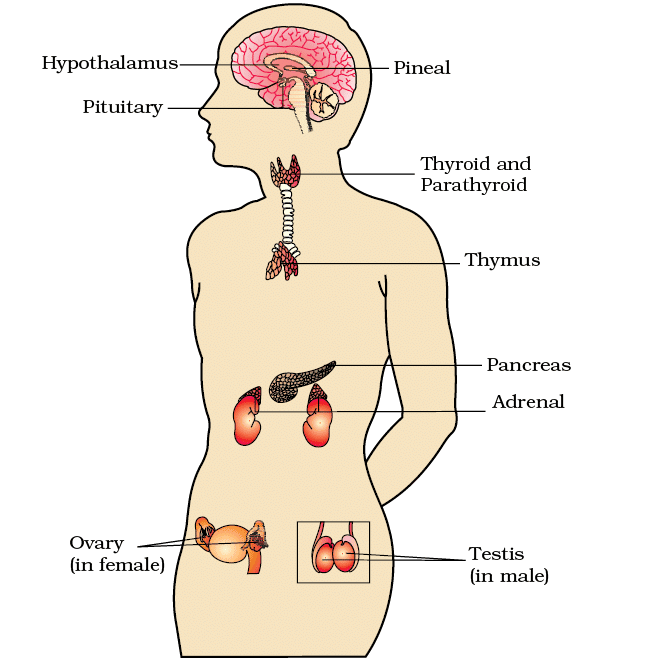 Location of Endocrine Glands
Location of Endocrine Glands
1. Hypothalamus
- Location: Basal diencephalon, forebrain.
- Function: Neurosecretory nuclei produce releasing (e.g., GnRH for gonadotrophins) and inhibiting hormones (e.g., somatostatin for GH) to regulate pituitary via portal circulation or direct neural control (posterior pituitary).
2. Pituitary Gland
- Location: Sella turcica, linked to hypothalamus.
- Parts: Adenohypophysis (pars distalis: GH, PRL, TSH, ACTH, LH, FSH; pars intermedia: MSH, merged in humans) and neurohypophysis (stores oxytocin, vasopressin from hypothalamus).
- Hormones and Functions:
- GH: Growth (over-secretion: gigantism/acromegaly; under-secretion: dwarfism).
- PRL: Mammary gland growth, milk production.
- TSH: Thyroid hormone synthesis.
- ACTH: Glucocorticoid synthesis (adrenal cortex).
- LH/FSH (Gonadotrophins): Gonadal activity (males: LH-androgens, FSH-spermatogenesis; females: LH-ovulation, corpus luteum, FSH-follicle growth).
- MSH: Skin pigmentation.
- Oxytocin: Uterine contraction (childbirth), milk ejection.
- Vasopressin (ADH): Water reabsorption (kidney), deficiency causes diabetes insipidus.
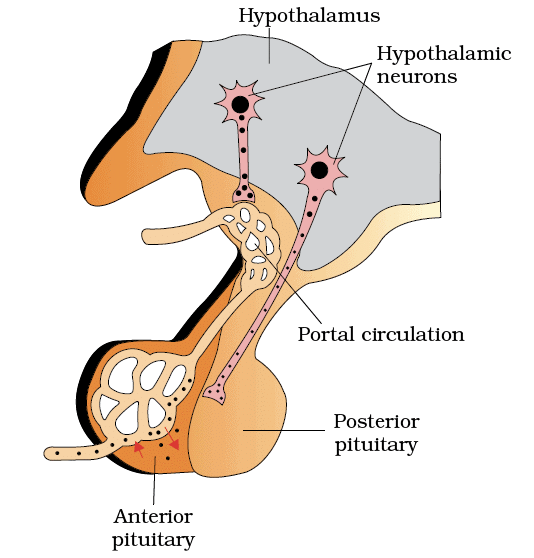
3. Pineal Gland
- Location: Dorsal forebrain.
- Hormone: Melatonin regulates diurnal rhythms (sleep-wake, temperature), metabolism, pigmentation, menstrual cycle, defense.
4. Thyroid Gland
- Location: Two lobes on trachea, linked by isthmus.
- Hormones: T₃, T₄ (follicular cells, need iodine), TCT (protein hormone).
- Functions: Basal metabolic rate, RBC formation, metabolism (carbs, proteins, fats), water/electrolyte balance; TCT lowers blood Ca²⁺.
- Disorders: Hypothyroidism (goitre, cretinism in infants, irregular menstruation); hyperthyroidism (exophthalmic goitre/Graves’ disease: enlarged gland, bulging eyes, high metabolism, weight loss).
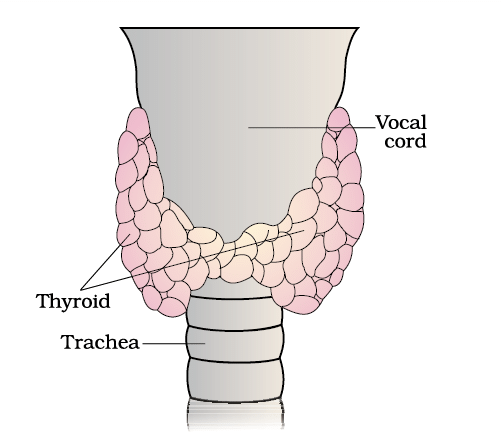
5. Parathyroid Gland
- Location: Four glands on thyroid’s dorsal side.
- Hormone: PTH (peptide, Ca²⁺-regulated).
- Functions: Increases blood Ca²⁺ via bone resorption, renal reabsorption, food absorption; hypercalcemic, balances Ca²⁺ with TCT.
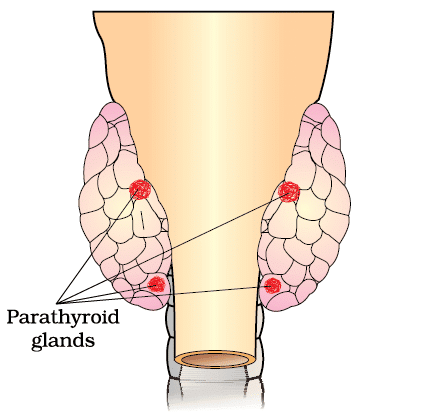
6. Thymus
- Location: Between lungs, ventral to aorta.
- Hormone: Thymosins (peptides).
- Functions: T-lymphocyte differentiation (cell-mediated immunity), antibody production (humoral immunity); degenerates in old age, weakening immunity.
7. Adrenal Gland
- Location: One atop each kidney.
- Parts: Medulla (catecholamines: adrenaline, noradrenaline); Cortex (corticoids: glucocorticoids like cortisol, mineralocorticoids like aldosterone).
- Functions:
- Catecholamines: Emergency response (alertness, pupil dilation, piloerection, heart rate, respiration, glycogenolysis, lipolysis, proteolysis).
- Glucocorticoids: Gluconeogenesis, lipolysis, proteolysis, anti-inflammatory, RBC production, cardio-vascular/kidney maintenance.
- Mineralocorticoids: Na⁺/water reabsorption, K⁺/phosphate excretion (electrolyte/fluid balance, blood pressure).
- Androgenic steroids: Pubic/axillary hair growth.
- Disorder: Addison’s disease (cortex underproduction: weakness, fatigue).
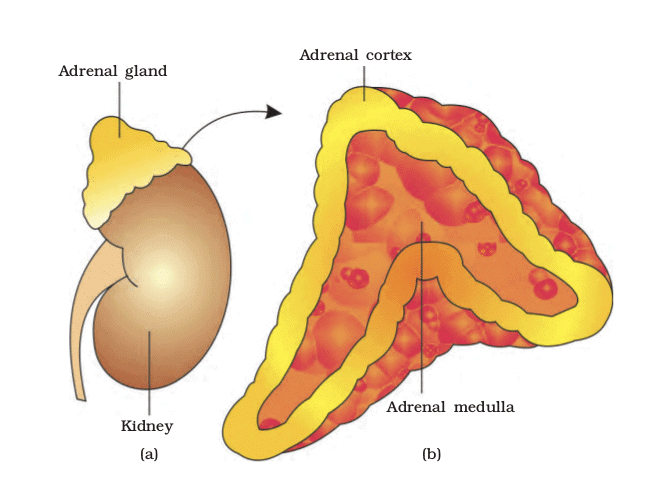
Adrenal Gland
8. Pancreas
- Location: Composite gland (exocrine/endocrine).
- Endocrine Part: Islets of Langerhans (α-cells: glucagon; β-cells: insulin).
- Functions:
- Glucagon: Hyperglycemic (glycogenolysis, gluconeogenesis, reduces glucose uptake).
- Insulin: Hypoglycemic (glucose uptake/utilization, glycogenesis); deficiency/resistance causes diabetes mellitus (high glucose, urine loss, ketone bodies).
9. Testis
- Location: Scrotal sac.
- Hormone: Androgens (testosterone, from Leydig cells).
- Functions: Male accessory organ development, secondary sex characters (hair, voice, aggression), spermatogenesis, libido, anabolic effects.
10. Ovary
- Location: Abdomen.
- Hormones: Estrogen (follicles), progesterone (corpus luteum).
- Functions:
- Estrogen: Female secondary sex organs/characters (voice, mammary glands), follicle growth, sexual behavior.
- Progesterone: Pregnancy support, mammary gland alveoli formation, milk secretion.
Hormones of Heart, Kidney, and GI Tract
- Heart: Atrial natriuretic factor (ANF) decreases blood pressure by vasodilation.
- Kidney: Erythropoietin stimulates RBC formation (erythropoiesis).
- GI Tract:
- Gastrin: HCl, pepsinogen secretion.
- Secretin: Pancreatic water, bicarbonate secretion.
- CCK: Pancreatic enzymes, bile juice secretion.
- GIP: Inhibits gastric secretion/motility.
- Other: Growth factors from non-endocrine tissues aid growth/repair.
Mechanism of Hormone Action
Hormones bind specific receptors (membrane-bound or intracellular) forming hormone-receptor complexes, triggering biochemical changes.
- Types:
- Peptide/Protein: e.g., insulin, pituitary hormones.
- Steroids: e.g., cortisol, testosterone.
- Iodothyronines: e.g., thyroid hormones.
- Amino-acid derivatives: e.g., epinephrine.
- Action:
- Membrane-bound (peptide): Generate second messengers (cAMP, IP₃, Ca²⁺) for cellular metabolism.
- Intracellular (steroid, iodothyronines): Regulate gene expression via nuclear receptors.
Summary
Hormones, produced by endocrine glands (e.g., pituitary, thyroid) and other tissues (e.g., heart, kidney), coordinate metabolism, growth, and development. The hypothalamus regulates pituitary hormones, which control peripheral glands. Key hormones include thyroid (metabolism), adrenal (stress, electrolytes), pancreatic (glucose), and gonadal (reproduction). Non-endocrine hormones (e.g., ANF, erythropoietin) and growth factors also play roles. Hormones act via specific receptors, using second messengers or gene regulation.







 Location of Endocrine Glands
Location of Endocrine Glands























